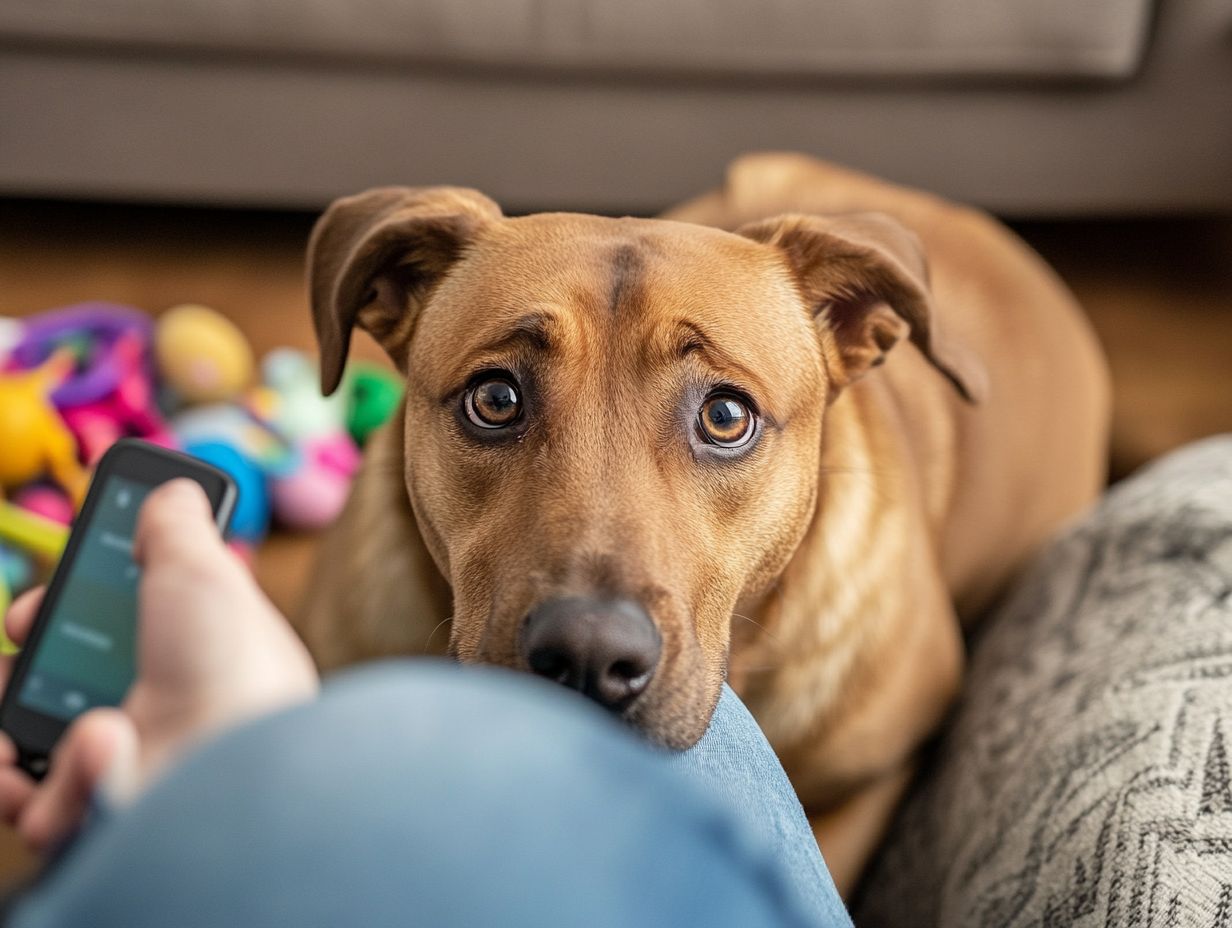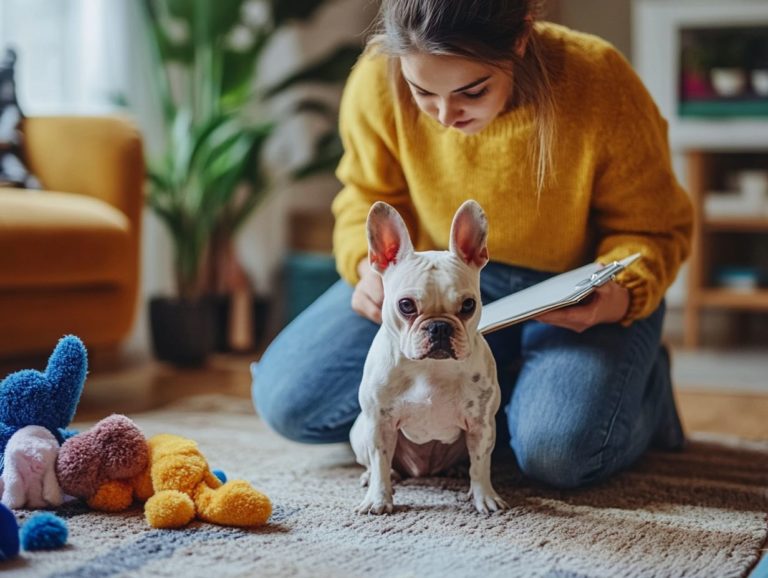When to Consult a Professional for Pet Anxiety
Understanding pet anxiety is key to ensuring your furry friend is happy and healthy! Pets can feel anxiety just like you, and recognizing the signs is the crucial first step in providing the support they need.
This article delves into common behavioral changes that may signal anxiety, such as separation anxiety and fear-related anxiety. It also discusses potential triggers affecting them and guidance on when to seek professional help.
It covers various treatment options for dog anxiety and effective strategies to prevent it, empowering you to create a more serene environment for your beloved pet.
Contents
- Key Takeaways:
- Symptoms of Pet Anxiety
- Causes of Pet Anxiety
- When to Seek Professional Help
- Treatment Options for Pet Anxiety
- Preventing Pet Anxiety
- Frequently Asked Questions
- When should I consult a professional for pet anxiety?
- What are some signs that my pet may be experiencing anxiety?
- How can a professional help my pet with anxiety?
- What types of professionals can help with pet anxiety?
- Can pet anxiety be treated without consulting a professional?
- Is pet anxiety a common issue?
Key Takeaways:

- Monitor your pet for behavioral changes and seek professional help if anxiety impacts their quality of life.
- Treatment options for pet anxiety include medications, therapy, and preventative strategies.
Symptoms of Pet Anxiety
Pet anxiety, especially in dogs, reveals itself through various symptoms that can profoundly affect their behavior and overall well-being. As a dog owner or veterinarian, understanding these symptoms is essential, as they may indicate issues like separation anxiety or fear-related anxiety.
By recognizing these signs early, you can pave the way for effective interventions and treatments, preventing the situation from escalating into more serious behavioral concerns.
Behavioral Changes to Look Out For
Behavioral changes in dogs can be key indicators of underlying anxiety issues. Recognizing these shifts in behavior is critical, especially for specific breeds that may be more susceptible.
Certain breeds like the Labrador Retriever may display increased aggression or excessive barking when anxious, while others, such as the Chihuahua, might withdraw and hide. You may also notice compulsive behaviors, like tail chasing or obsessive licking, signaling that your dog is experiencing anxiety.
By paying close attention to these signs, you can better address your pet’s emotional needs, leading to a happier and healthier canine companion.
Causes of Pet Anxiety
Understanding the causes of pet anxiety is crucial for developing effective treatment and prevention strategies. This knowledge allows you to create a supportive environment for your dog.
Common triggers of anxiety can include separation anxiety, fear-related anxieties, and aging-related issues, which stem from conditions that affect memory and thinking in older dogs.
Recognizing these triggers is essential for addressing your dog’s emotional and psychological needs, ultimately ensuring their overall well-being.
Possible Triggers and Contributing Factors

Possible triggers and contributing factors for your dog’s anxiety can vary widely, including environmental changes, loud noises, and a lack of socialization.
Changes in routine, unfamiliar visitors, or specific weather conditions can significantly amplify anxiety symptoms. Dogs may react negatively to the sounds of thunder, fireworks, or construction noise, leading to behaviors such as excessive barking or destructive chewing.
It’s essential to recognize these potential stressors and understand how they might intertwine with behavioral issues. Seeking advice from a veterinarian is crucial, as professionals can offer tailored strategies and treatment options to help mitigate these anxiety triggers, paving the way for a happier and more balanced life for your beloved pet.
If you notice signs of anxiety in your pet, don’t hesitate to contact your veterinarian or try specific strategies at home to support their well-being.
When to Seek Professional Help
Recognizing the right moment to seek professional assistance for your dog’s anxiety is essential for safeguarding their mental and emotional well-being. Pay attention to symptoms that may signal an anxiety disorder, such as extreme fear, excessive barking, destructive behavior, or shifts in appetite.
Consulting with a veterinarian or a qualified dog trainer provides invaluable insights and tailored treatment options specifically for your dog’s unique needs.
Signs that Your Pet Needs Professional Assistance
Signs that your pet needs professional assistance can appear in various ways, from anxiety symptoms to aggressive behavior.
If you notice your pet struggling to settle down, constantly pacing, or whining, this may indicate underlying stress that warrants intervention.
Destructive behaviors, like chewing on furniture or scratching at doors, lead to costly damages and signal deeper emotional turmoil that needs addressing.
Aggression towards other animals or unfamiliar people can be particularly concerning, hinting at a potential threat to the safety of others.
Recognizing these signs is essential. Addressing them promptly with the help of a trained specialist can create a healthier environment for both your pet and your family.
Treatment Options for Pet Anxiety
Explore effective treatment options for dog anxiety now to help your beloved pet live a happier, healthier life. Consider various methods, including anxiety medications like fluoxetine or clomipramine, as well as natural therapies such as CBD oil and behavioral training strategies.
By blending these approaches, you can create a comprehensive anxiety treatment plan specifically designed to meet your dog’s unique needs.
Medications, Therapy, and Other Approaches

Medications, therapy, and various approaches are essential in addressing dog anxiety, offering much-needed relief and stability for your beloved pet.
For many canine companions, veterinarians may prescribe anti-anxiety medications like fluoxetine and sertraline to help manage their symptoms. These medications work by balancing neurotransmitters in the brain, aiming to diminish feelings of fear or panic.
However, these medications come with potential side effects, including nausea, drowsiness, and changes in appetite.
Therapeutic techniques like desensitization and counter-conditioning can be very effective. These methods involve gradually exposing your dog to anxiety triggers in a controlled setting, combined with positive reinforcement, fostering a more relaxed response over time.
Preventing Pet Anxiety
Preventing pet anxiety is within your grasp through proactive measures, including anxiety prevention tips and effective training strategies that encourage socialization and positive experiences.
By gaining insight into the common causes of anxiety in dogs, you can cultivate an environment that minimizes triggers and nurtures stronger behavior.
Take these steps to greatly enhance your dog’s overall well-being and significantly decrease the chances of developing anxiety disorders in the long run.
Strategies for Reducing Anxiety in Pets
Implementing effective strategies to reduce anxiety in your pets can lead to remarkable improvements in their behavior and overall well-being. This proactive approach enhances the quality of life for your furry companions and nurtures a harmonious bond between you and your dog.
Prioritize key anxiety prevention tips like regular exercise and proper socialization to create a stable and enriching environment. Engaging in training activities, providing mental stimulation through puzzles, and seeking out opportunities for social interaction with other animals can significantly alleviate feelings of stress.
Remember, environmental enrichment is vital. It keeps dogs mentally engaged, allowing them to thrive in various settings, whether at home or out in the great outdoors.
Frequently Asked Questions
When should I consult a professional for pet anxiety?

You should consult a professional for pet anxiety when your pet’s anxiety, such as anxiety disorders, is significantly impacting their quality of life or your relationship with them.
What are some signs that my pet may be experiencing anxiety?
Signs of pet anxiety can include excessive panting, pacing, and destructive behavior. Other signs are excessive barking or meowing, hiding, and changes in appetite or bathroom habits.
How can a professional help my pet with anxiety?
A professional, such as a veterinarian or certified animal behavior consultant, can help your pet with anxiety by identifying the root cause and developing a personalized treatment plan. This may include behavior modification techniques, medication, and alternative treatments such as hemp products.
What types of professionals can help with pet anxiety?
Veterinarians, veterinary behaviorists, and certified animal behavior consultants can help with pet anxiety.
Can pet anxiety be treated without consulting a professional?
You can manage some cases of pet anxiety without a professional by implementing environmental and lifestyle changes. However, if the anxiety persists or worsens, it is important to seek professional help. Act now, and don t let anxiety control your pet s life!
Is pet anxiety a common issue?
Absolutely! Many pets face anxiety. Addressing it early can prevent bigger issues later.






